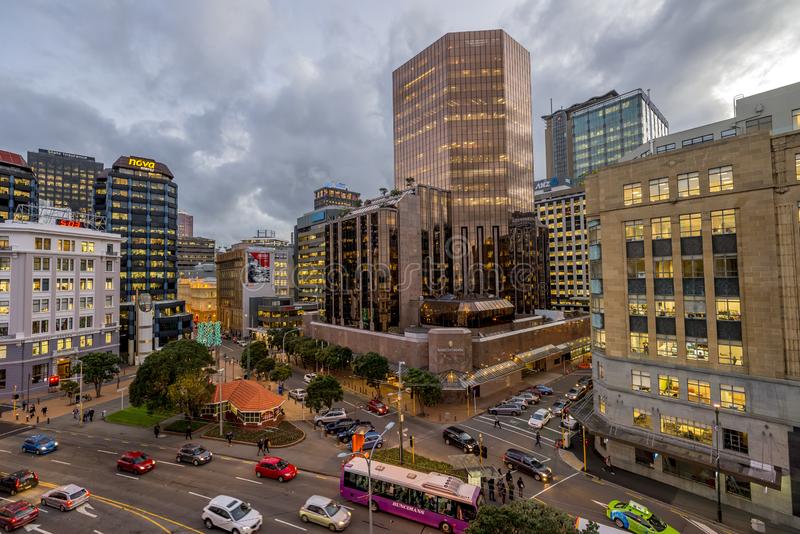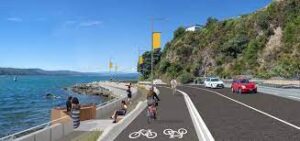While researching the next stage of this complicated argument, I have concluded there are both pros and cons to this move by Wellington City Council (WCC) and the Let’s Get Wellington Moving project (LGWM). Therefore, it is only fair and reasonable to explore both sides of the argument.
The Argument Against Removing Cars from Central Wellington.
I would like to begin with a short story. One Saturday I drove my brother and his wife to Lambton Quay, to go first to TSB Bank and then to do some shopping. My brother’s wife is disabled and is unable to walk long distance. I dropped them at TSB and noticed that all carparks were full. The Quay was busy with shoppers. I then drove to The Terrace to find the only carpark available that allowed me direct access to Whitcoulls.
With no access to Lambton Quay, as is proposed, I would not have been able to drop my brother and his wife at the bank (closed, of course), or to do some shopping. I later met them at Whitcoulls for coffee and cake at Sierra Café. The point is, if I did not have access to Lambton Quay, we would not have come into town and neither would we have spent money. In all likelihood, I would have been unable to get a carpark on The Terrace, as all carparks on this street would have been full (the carpark under the motorway would be too far for my brother’s wife to walk to the bank).
This is a simple example of how the proposal to remove cars, not only from the golden mile, but all central Wellington, will affect retail owners and shoppers, especially the elderly and disabled.
Why is this Potentially Dangerous and Undemocratic?
On 9 August 2020, Retail NZ made its submission against removing cars from the golden mile and side streets. Their submission, on behalf of 300 retailers has been totally ignored by LGWM and the WCC. Both these parties are ideologically driven, and the Retail NZ narrative does not fall into their ideology. Therefore, the Retail NZ submission has been totally ignored and an undemocratic process has occurred. Consideration has not been given to retail, or the implications that removing cars from central Wellington will have on retail. Tamatha Paul (WCC) has proposed a motion to prohibit all cars from central Wellington, not just the golden mile (Dominion Post, 9 April 2021). This proposal was supported by nine councillors, with a total lack of regard for the concerns of retail.
The same article refers to the Netherlands and Oslo as good examples of carless cities. Interestingly, Amsterdam has undertaken this same approach. However, central Amsterdam has a much smaller footprint than the central Wellington district. Further, the removal of cars was to help tourism, and the city has a much greater population than Wellington. Following the Covid-19 outbreak, central Amsterdam was quiet as there were no tourists. Further, while there were no cars in Amsterdam, walking was dangerous due to the number of bicycles.
Wellington currently does not have the population or tourists that Amsterdam has. Darling Harbour in Sydney is carless, but draws on a population of five million and a pre Covid-19 tourist base, neither of which Wellington has. Great cities like London and New York have not removed cars from their centre as it is just not practical. (London has a congestion tax).
To design a carless city is fraught with problems. I quote from the Dominion Post of 9 April 2021; “A less traffic-intensive centre city would make it easier for residents (inner city residents that is) to get around but might lead to more problems. If we want to get to the satellite suburbs, like Kilbirnie or the airport, that would be harder’”
Last year, a colleague told me he had a friend who worked for LGWM. She told him it currently takes eight minutes to drive from the railway station to Mt Victoria tunnel. It was her desire to change this to forty minutes, thus making it much harder for cars to cross Wellington. Thus, those working in LGWM are not interested in an efficient, functioning city geared to all modes of traffic, but to excluding one form of transport – cars. Consequently, the thought process within LGWM is already flawed, prejudiced and undemocratic. As the 9 April 2021 article in the Dominion Post rightly pointed out, “banning private vehicles outright would be another punitive measure on travellers’”. If you are going to remove cars, you must provide incentives (which I will cover in the next article).
Central Wellington has already had failures in implementing “malls”. Manners St mall failed because people stopped coming due to an increase in crime and disorder, and consequently retail suffered. The street had to be re-opened, to buses at least. Then there was the recent experiment in lower Tory St. Once again, this impacted on the flow of traffic and people stopped going and retail suffered. It was a most bizarre project.
As the Retail NZ submission rightly points out in paragraph three, there “appears to be an ongoing series of anti-car policies being pursued by WCC, with decisions being made without full consideration of broader impacts”. Further, private vehicles play a vital role in allowing a diversity of shoppers to come to central Wellington. By removing or restricting cars, this could affect the viability of certain retail outlets, and as I pointed out in my previous article, not only forcing, but encouraging shopping in the satellite suburbs of Lower Hutt, Porirua and Kilbirnie, where parking is free and abundant. Shoppers will not necessarily be encouraged to take the bus or catch a train into Wellington.
We already have a poor bus service across Wellington. I live in a central Wellington suburb, but must catch two buses just to get to Courtenay Place. Then there are the trains. Porirua City Council is proposing to charge for parking at stations. So why take a train to go shopping in central Wellington?
There is not enough parking space in central Wellington as it is. As Retail NZ highlights, “The glaring omission in all three proposals is the provision of alternative parking options”. The WCC carpark on The Terrace under the motorway is full during the week and this only leaves the weekends for people to park and go shopping. There is waterfront parking, but this is expensive at $6 per half hour at the TSB Arena, and it is full during the week right out to the stadium. Thus, those wishing to shop in Wellington are reduced to only the weekends to come into town by car. This is not sustainable for retail.
I have not covered the impracticality of buying goods and carrying them home on the bus or train. As a client said to me, (he rides his bike to work every day), taking a bus across town instead of his car to go to hockey with all his gear is simply impractical.
Finally, what would be the cost to WCC in lost revenue? This would be hugely costly and only place more immense financial pressure on the council, with the inevitable increase in rates. This is another glaring omission on both the WCC and LGWM. Both have a narrow and prejudice vision that has only looked at one aspect of changes being considered, without considering the full implications of their motives and desires. It is simply blind ideology that seeks its own outcome at the expense of all others. That is dangerous.


